Discover 35 hidden attractions, cool sights, and unusual things to do in Seville (Spain). Don't miss out on these must-see attractions: Seville Cathedral, Alcázar of Seville, and Giralda. Also, be sure to include Torre del Oro in your itinerary.
Below, you can find the list of the most amazing places you should visit in Seville (Andalusia).
Table of Contents
Seville Cathedral
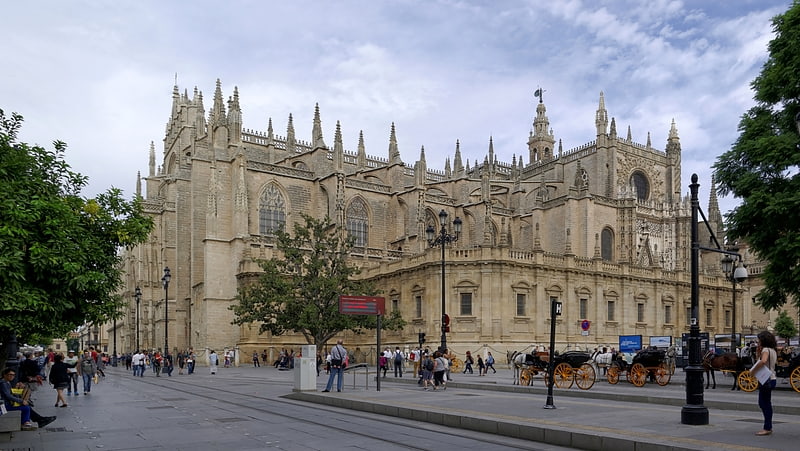
Also known as: Catedral de Sevilla
Gothic structure with iconic bell tower. The Cathedral of Saint Mary of the See, better known as Seville Cathedral, is a Roman Catholic cathedral in Seville, Andalusia, Spain. It was registered in 1987 by UNESCO as a World Heritage Site, along with the adjoining Alcázar palace complex and the General Archive of the Indies. It is the fourth-largest church in the world as well as the largest Gothic church.
After its completion in the early 16th century, Seville Cathedral supplanted Hagia Sophia as the largest cathedral in the world, a title the Byzantine church had held for a thousand years. The Gothic section alone has a length of 126 m (413 ft), a width of 76 m (249 ft), and its maximum height in the center of the transept is 42 m (138 ft). The total height of the Giralda tower from the ground to the weather vane is 104.5 m (342 ft 10 in).
Seville Cathedral was the site of the baptism of Infante Juan of Aragon in 1478, only son of the Catholic Monarchs Ferdinand II of Aragon and Isabella I of Castile. Its royal chapel holds the remains of the city's conqueror Ferdinand III of Castile, his son and heir Alfonso the Wise and their descendant king Peter the Just. The funerary monuments for cardinals Juan de Cervantes and Pedro González de Mendoza are located among its chapels. Christopher Columbus and his son Diego are also buried in the cathedral.
The Archbishop's Palace is located on the northeastern side of the cathedral.[1]
Address: Av. de la Constitución, s/n, 41004 Sevilla (Casco Antiguo)
Alcázar of Seville
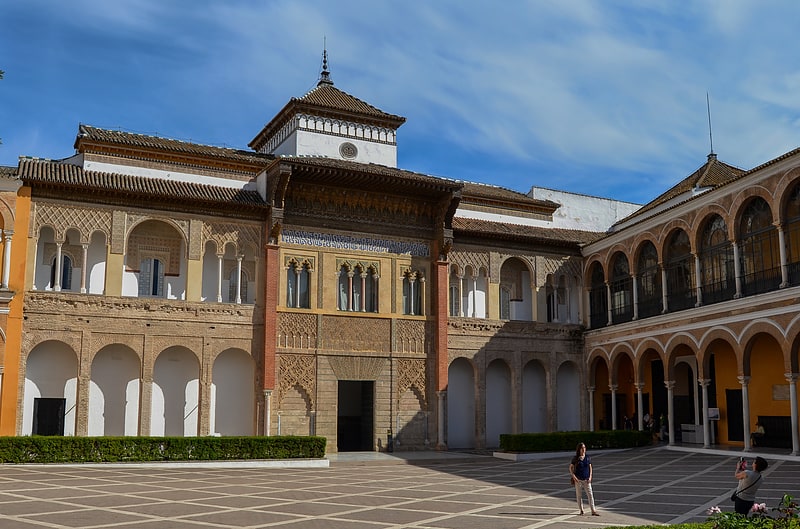
Also known as: Real Alcázar de Sevilla
Iconic Moorish-Renaissance royal palace. The Royal Alcázars of Seville, historically known as al-Qasr al-Muriq and commonly known as the Alcázar of Seville, is a royal palace in Seville, Spain, built for the Christian king Peter of Castile. It was built by Castilian Christians on the site of an Abbadid Muslim alcazar, or residential fortress. The fortress was destroyed after the Christian conquest of Seville in 1248.
The palace is a preeminent example of Mudéjar style in the Iberian Peninsula, combining Romanesque, Gothic, and Renaissance structural elements. The upper stories of the Alcázar are still occupied by the royal family when they visit Seville and are administered by the Patrimonio Nacional. It was registered in 1987 by UNESCO as a World Heritage Site, along with the adjoining Seville Cathedral and the General Archive of the Indies.[2]
Address: Patio de Banderas, s/n, 41004 Sevilla (Casco Antiguo)
Giralda
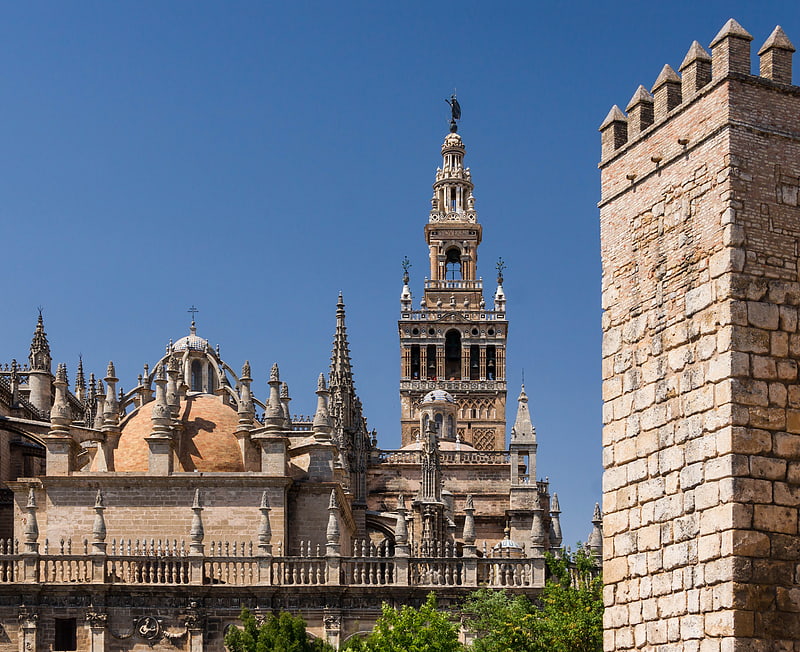
Bell tower atop a former minaret. The Giralda is the bell tower of Seville Cathedral in Seville, Spain. It was built as the minaret for the Great Mosque of Seville in al-Andalus, Moorish Spain, during the reign of the Almohad dynasty, with a Renaissance-style belfry added by the Catholics after the expulsion of the Muslims from the area. The Giralda was registered in 1987 as a World Heritage Site by UNESCO, along with the Alcázar and the General Archive of the Indies. The tower is 104.1 m in height and remains one of the most important symbols of the city, as it has been since the Middle Ages.[3]
Address: Av. de la Constitución, s/n, 41004 Sevilla (Casco Antiguo)
Torre del Oro
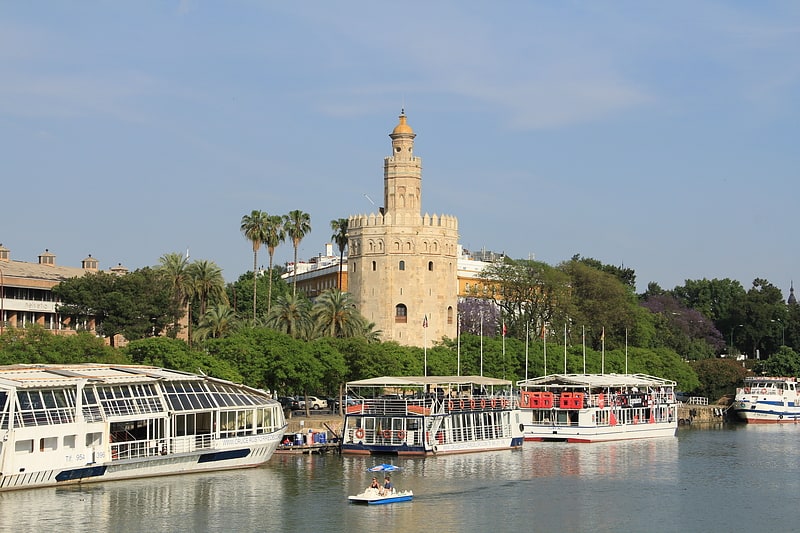
13th-century military watchtower. The Torre del Oro is a dodecagonal military watchtower in Seville, southern Spain. It was erected by the Almohad Caliphate in order to control access to Seville via the Guadalquivir river.
Constructed in the first third of the 13th century, the tower served as a prison during the Middle Ages. Its name comes from the golden shine it projected on the river, due to its building materials (a mixture of mortar, lime and pressed hay).
The tower is divided into three levels, the first level, dodecagonal, was built in 1220 by order of the Almohad governor of Seville, Abù l-Ulà; As for the second level, of only 8 meters, also dodecagonal, was built by Peter of Castile in the fourteenth century, a hypothesis that has been confirmed by archaeological studies; The third and uppermost being circular in shape was added after the previous third level, Almohad, was damaged by the 1755 Lisbon earthquake. Rebuilding of the third level was made by Brusselian military engineer Sebastian Van der Borcht in 1760.
The Torre de la Plata, an octagonal tower, is located nearby, and is believed to have been constructed during the same era.[4]
Address: Paseo de Cristóbal Colón, s/n, 41001 Sevilla (Casco Antiguo)
Palacio de San Telmo
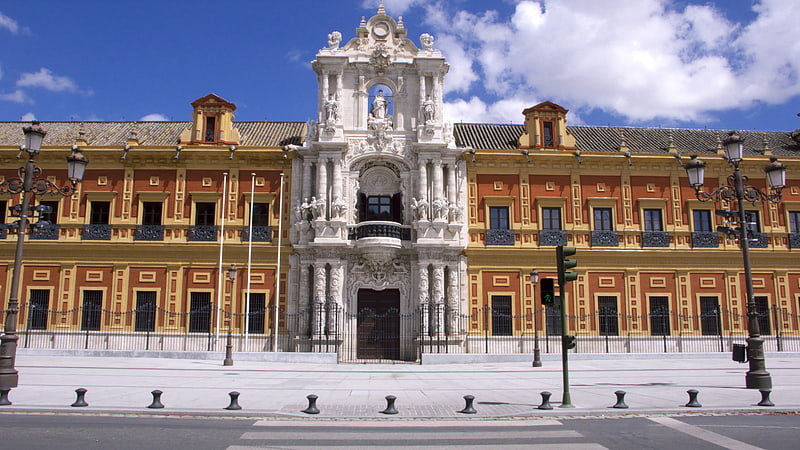
Baroque palace and government seat. The Palace of San Telmo is a historical edifice in Seville, southern Spain, formerly the Universidad de Mareantes, now is the seat of the presidency of the Andalusian Autonomous Government. Construction of the building began in 1682 outside the walls of the city, on property belonging to the Tribunal of the Holy Office, the institution responsible for the Spanish Inquisition. It was originally constructed as the seat of the University of Navigators, a school to educate orphaned children and train them as sailors.[5]
Address: Av. de Roma, Seville (Casco Antiguo)
María Luisa Park
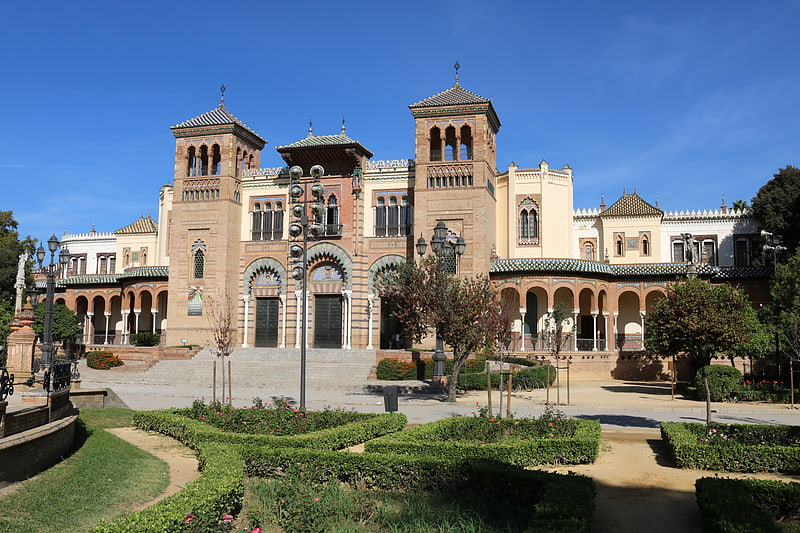
Also known as: Parque de María Luisa
Large, famous park with with plazas. The Parque de María Luisa is a public park that stretches along the Guadalquivir River in Seville, Spain. It is Seville's principal green area.[6]
Address: Av. María Luisa, 41013 Sevilla (Sur)
General Archive of the Indies
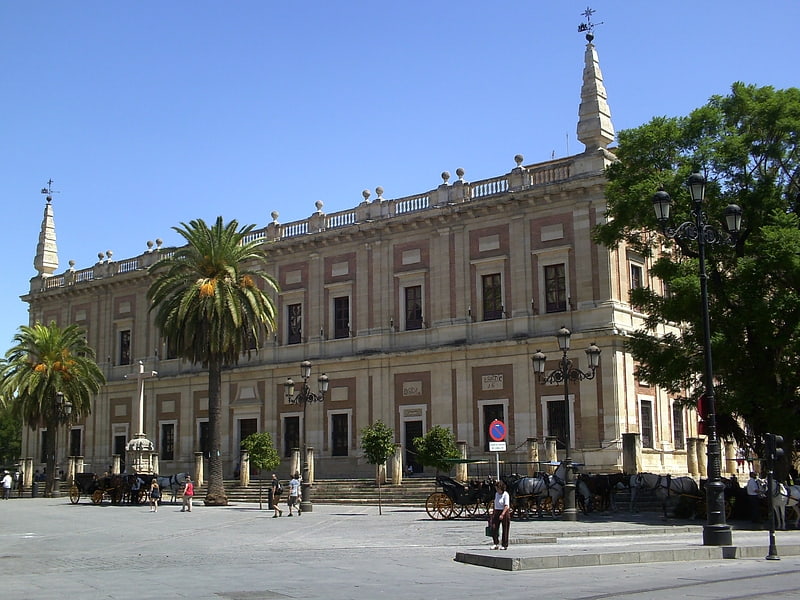
Also known as: Archivo General de Indias
UNESCO-listed historical archive. The Archivo General de Indias, housed in the ancient merchants' exchange of Seville, Spain, the Casa Lonja de Mercaderes, is the repository of extremely valuable archival documents illustrating the history of the Spanish Empire in the Americas and Asia. The building itself, an unusually serene and Italianate example of Spanish Renaissance architecture, was designed by Juan de Herrera. This structure and its contents were registered in 1987 by UNESCO as a World Heritage Site together with the adjoining Seville Cathedral and the Alcázar of Seville.[7]
Address: Avenida Constitucion s/n, 41004 Seville (Casco Antiguo)
Museo de Bellas Artes
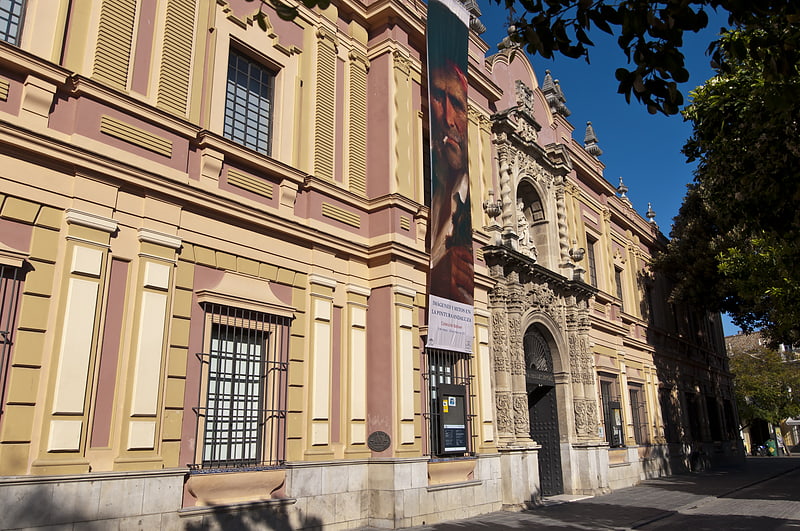
Fine-art museum in a 17th-century palace. The Museum of Fine Arts of Seville is a museum in Seville, Spain, a collection of mainly Spanish visual arts from the medieval period to the early 20th century, including a choice selection of works by artists from the so-called Golden Age of Sevillian painting during the 17th century, such as Murillo, Zurbarán, Francisco de Herrera the younger, and Valdés Leal.
The building itself was built in 1594. The institution of the provincial museum of Seville was created in September 1835. Items were moved to the museum in the ensuing years. The building it is housed in was originally home to the convent of the Order of the Merced Calzada de la Asunción, founded by St. Peter Nolasco during the reign of Ferdinand III. Extensive remodeling in the early 17th century was led by the architect Juan de Oviedo y de la Bandera.[8]
Address: Plaza Museo 9, 41001 Seville (Casco Antiguo)
Football
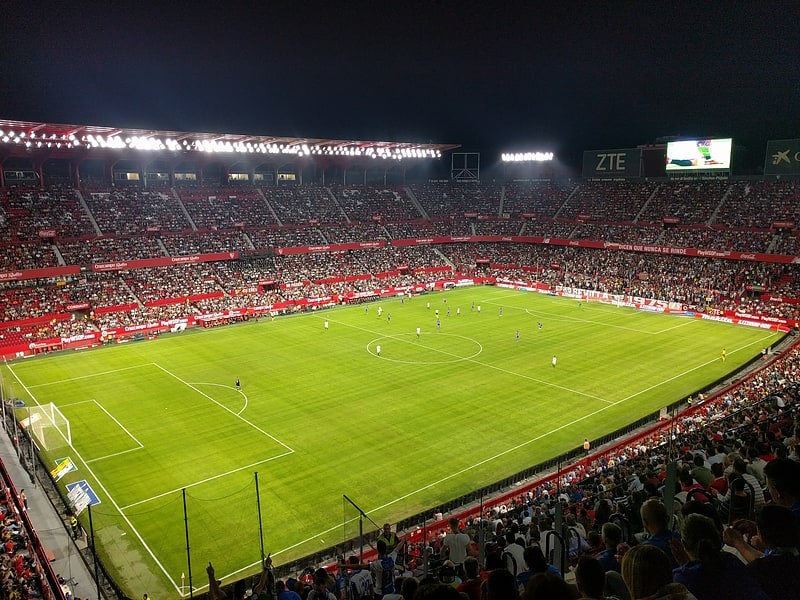
Also known as: Estadio Ramón Sánchez-Pizjuán
Stadium in Seville, Spain. The Ramón Sánchez Pizjuán Stadium is a football stadium in Seville, Spain. It is the home stadium of Sevilla Fútbol Club, and is named after the club's former president, Ramón Sánchez-Pizjuán.
It was the venue for the 1986 European Cup Final between Steaua București and Barcelona and the 1982 World Cup semi-final game between West Germany and France.
With a capacity of 42,714 seats, Ramón Sánchez Pizjuán is the ninth-largest stadium in Spain and the third-largest in Andalusia.[9]
Address: Calle Sevilla Futbol Club, S/N, 41005 Seville (Nervión)
Macarena Gate
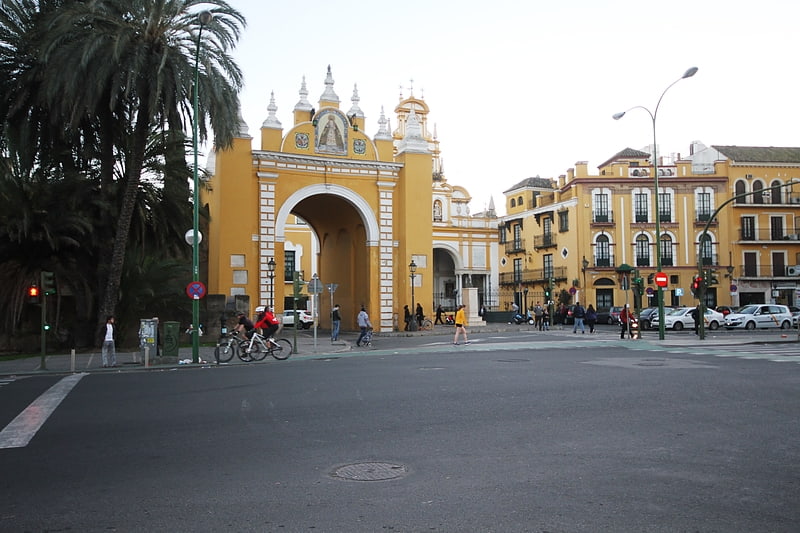
Also known as: Puerta de la Macarena
Tourist attraction in Seville, Spain. The Puerta de la Macarena, also known as Arco de la Macarena, stands alongside the Postigo del Aceite and the Puerta de Córdoba the only three city gates that remain today of the original walls of Seville. It is located in the calle Resolana, within of barrio de San Gil, which belongs to the district of Casco Antiguo of the city of Seville, in Andalusia, Spain. The gate faces the Basílica de La Macarena, which houses the image of the Our Lady of la Esperanza Macarena, one of the most characteristic images of the Holy Week in Seville.
This is the entrance of the walls located further north of the city, and the higher of the set, and is one of the few remnants that remain from the walls of the city, along with the cloth of the walls that it connects with the Puerta de Córdoba through a wall in which are preserved seven towers. Although the enclosure walled of the city was built in time of Julius Caesar on the former Carthaginian defense, the gate corresponds to the extension made by the Sultan Ali ibn Yusuf in the 12th century, and its present appearance is the result of a remodeling carried out between the years 1723 and 1795, in which the Islamic architectural elements were replaced by the classicist air which presents today.
It was the gate used by the kings who visited for the first time the city, and to its walls it rose an altar in that performing their lawsuit tribute, and after which were handed the keys of the city to they, and so did Alfonso XI of Castile (1327), Isabella I of Castile (1477), Ferdinand II of Aragon (1508), Charles V, Holy Roman Emperor and his fiancee Isabella of Portugal (1526), and finally Philip IV (1624).
Crowns the set the ceramic altarpiece by painter Manuel Rodríguez representing the Virgin of Hope of Macarena, inaugurated in 1923 by the infanta Maria de la Esperanza of Bourbon-Two Sicilies.
The remains of the walled city, among which includes this gate, were declared Bien de Interés Cultural in 1985.[10]
Address: Calle San Luis, 134, 41003 Sevilla (Casco Antiguo)
Costurero de la Reina

Historical landmark in Seville, Spain. The Costurero de la Reina is a building constructed in the late nineteenth century in the gardens of the Palace of San Telmo, now the Maria Luisa Park in Seville, Spain. This unique building takes the form of a small hexagonal castle with turrets at the corners.
The building was the guard house or garden retreat. It is the oldest building in Seville in the neomudéjar style. The name comes from a popular tradition that Mercedes of Orléans, the future wife of King Alfonso XII of Spain, retired to the pavilion where she passed her time sewing. The reality is more prosaic. The formal name is the "Pavilion of San Telmo". Mercedes died of typhus about fifteen years before the building was erected in 1893.
Nowadays the Costurero de la Reina lodges the tourist information office on the ground floor. The opening times are 9-2 pm and 3.30 to 7.30 pm, on weekdays and 10-2pm during weekends and bank holidays. The building was restored in the spring of 2007 to repair the main structure and to arrange the interior in order to make it more functional. The first floor was refurbished recently and it is used as meetings and events room of the local government.[11]
Address: Paseo de las Delicias, 9, 41013 Sevilla (Casco Antiguo)
Casa de Pilatos
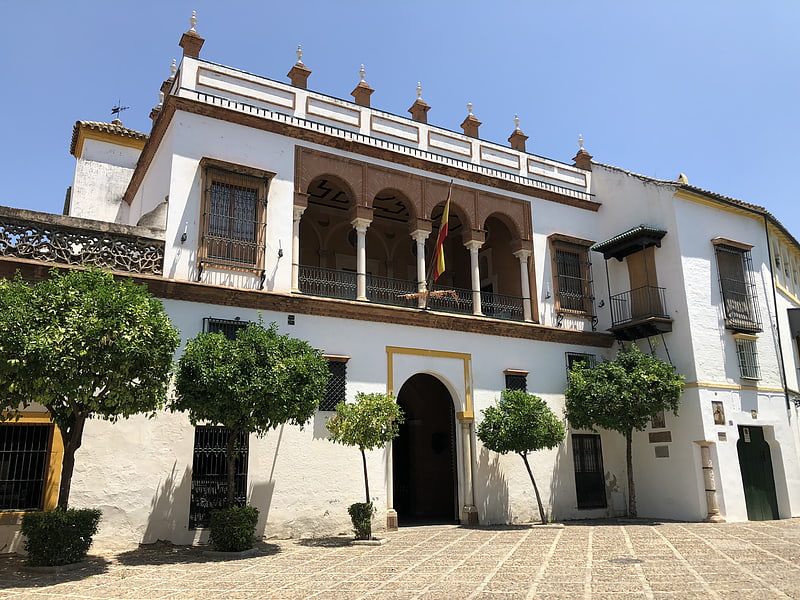
Ducal palace with courtyards and artworks. La Casa de Pilatos is an Andalusian palace in Seville, Spain, which serves as the permanent residence of the Dukes of Medinaceli. It is an example of an Italian Renaissance building with Mudéjar elements and decorations. It is considered the prototype of the Andalusian palace.
The Casa de Pilatos has around 150 different 1530s azulejo (Spanish glazed tile) designs made by the brothers Diego and Juan Pulido, one of the largest azulejo collections in the world.[12]
Address: Plaza Pilatos 1, 41003 Seville (Casco Antiguo)
Museo de Artes y Costumbres Populares

Museum in Seville, Spain. The Museum of Arts and Popular Customs of Seville is a museum in Seville, Andalusia, Spain, located in the María Luisa Park, across the Plaza de América from the Provincial Archeological Museum. The museum had 84,496 visitors in 2007.[13]
Address: Plaza de America, 3, 41013 Seville (Sur)
Triana
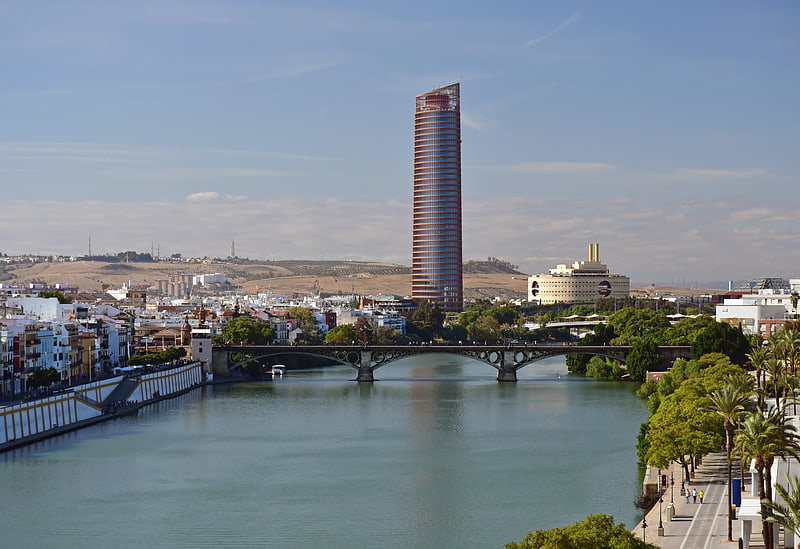
Also known as: Puente de Isabel II
Arch bridge in Seville, Spain. The Puente de Isabel II, Puente de Triana or Triana Bridge, is a metal arch bridge in Seville, Spain, that connects the Triana neighbourhood with the centre of the city. It crosses the Canal de Alfonso XIII, one of the arms of the River Guadalquivir that isolate Triana as an almost-island.
It was built during the reign of Isabella II of Spain and completed in 1852 as the first solid bridge in Seville, replacing an earlier floating bridge consisting of boats (a pontoon bridge). First built by the Moors in the 12th century, the pontoon bridge managed to exist for seven centuries due to later repairs.[14]
Address: Puente de Triana, 41010 Sevilla (Triana)
Monastery of Santa Maria de las Cuevas
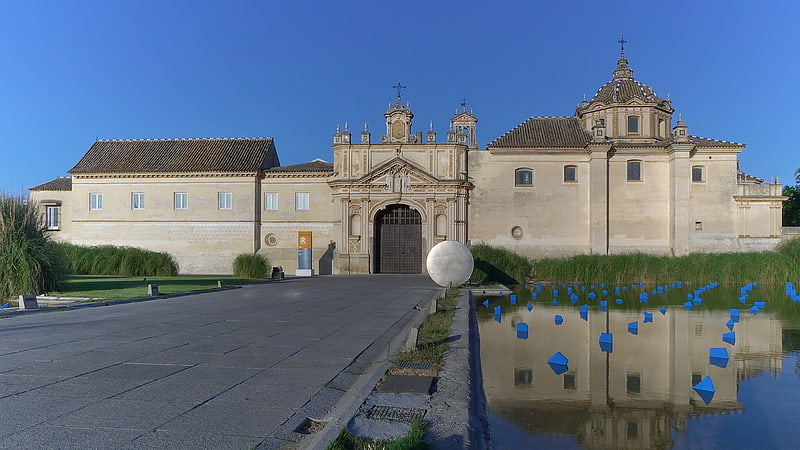
Also known as: Monasterio de la Cartuja
Art museum in Seville, Spain. The Monastery of Santa María de las Cuevas, also known as the Monastery of the Cartuja, is a religious building on the Isla de La Cartuja in Seville, southern Spain. The Andalusian Contemporary Art Center is now located on this site.[15]
Address: Av. de Américo Vespucio, 2, 41092 Sevilla (Triana)
Museo Arqueológico de Sevilla

Archaeological museum in 1920s pavilion. The Archeological Museum of Seville is a museum in Seville, southern Spain, housed in the Pabellón del Renacimiento, one of the pavilions designed by the architect Aníbal González. These pavilions at the Plaza de España were created for the Ibero-American Exposition of 1929.[16]
Address: Plaza de America s/n, 41013 Seville (Sur)
Puente del Alamillo

Modern bridge with a pedestrian walkway. The Alamillo Bridge is a structure in Seville, Andalucia, which spans the Canal de Alfonso XIII, allowing access to La Cartuja, a peninsula located between the canal and the Guadalquivir River. The bridge was constructed as part of infrastructure improvements for Expo 92, which was held on large banana farms on the island. Construction of the bridge began in 1989 and was completed in 1992 from a design by Santiago Calatrava.[17]
Address: SE-30 Km. 21, Seville (Triana)
Palacio Arzobispal
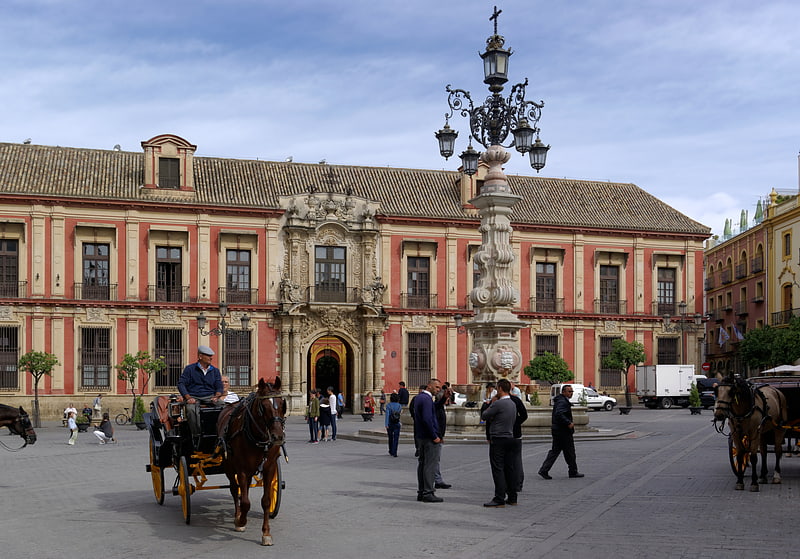
Also known as: Palacio arzobispal de Sevilla
The Archbishop's Palace of Seville is a palace in Seville, Spain. It has served as the residence of bishops and archbishops of the episcopal sees and numerous nobleman and military figures to the present time. It is located in the southern section of Seville, in the Plaza Virgen de los Reyes, angled almost opposite the Giralda. It is situated on the northeastern side of Seville Cathedral in the neighborhood of Santa Cruz. Of Spanish Baroque architectural style, it has had the status of National Monument since 1969.[18]
Address: Plaza Virgen de los Reyes s/n, 41004 Seville (Casco Antiguo)
Cemetery of San Fernando
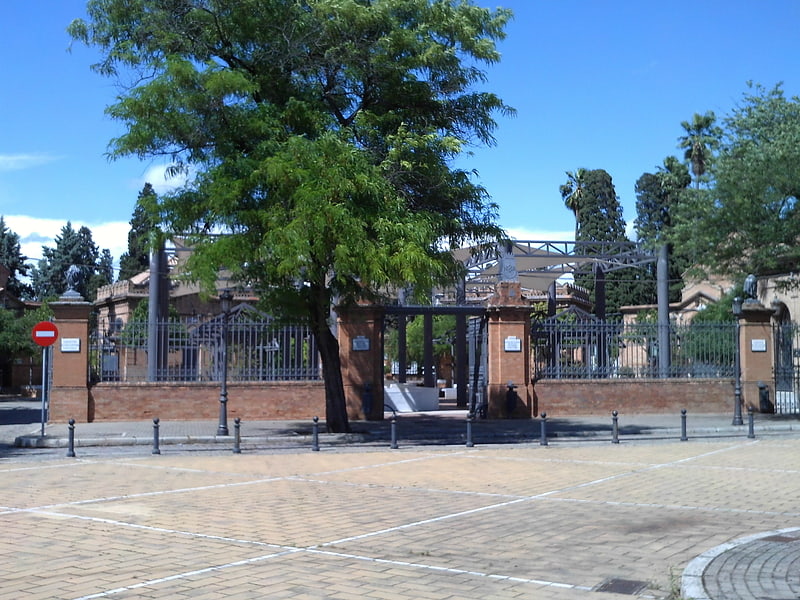
The Cemetery of San Fernando is located in the San Jerónimo district, north of the city of Seville, Andalusia, Spain. It was built in 1852, and it is the only municipal cemetery in the city. It has an area of 28 hectares and is considered as one of the most famous cemeteries in Spain.[19]
Palacio de la Condesa de Lebrija
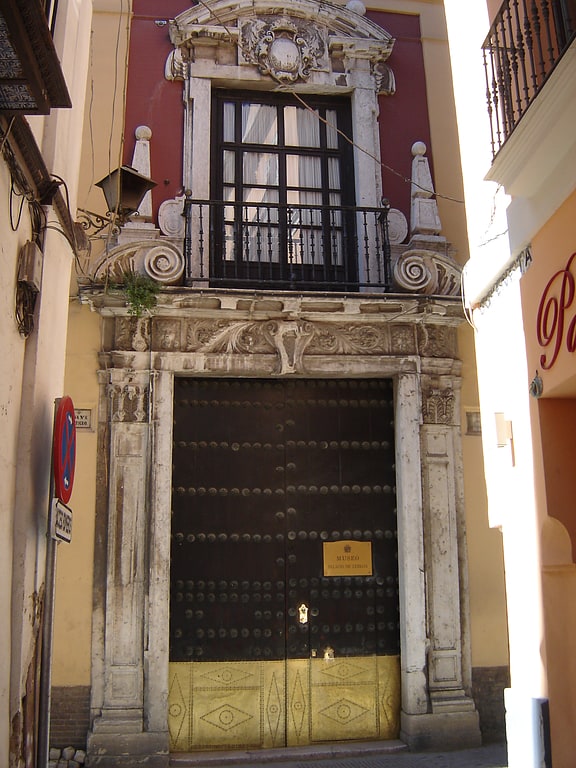
Also known as: Palacio de la condesa de Lebrija
Palace decorated with Roman mosaics. The Lebrija Palace or Palacio de la Condesa de Lebrija is a house-museum in central Seville, Spain. Dating to the 16th century and remodeled between the 18th and 20th centuries, the palace is characterised by its collection of art, including Roman mosaics and other antiquities as well as Asian art, paintings by European masters and European decorative arts.
The interior of the palace is decorated in a palette of architectural styles, with elements such as Moorish arches, Plateresque decoration, tilework retrieved from ruined convent, a coffered ceiling from a 16th-century palace and a Renaissance frieze, while its façade and layout reflect typical Andalusian style.[20]
Address: Calle Cuna 8, 41004 Seville (Casco Antiguo)
Birth of a New Man
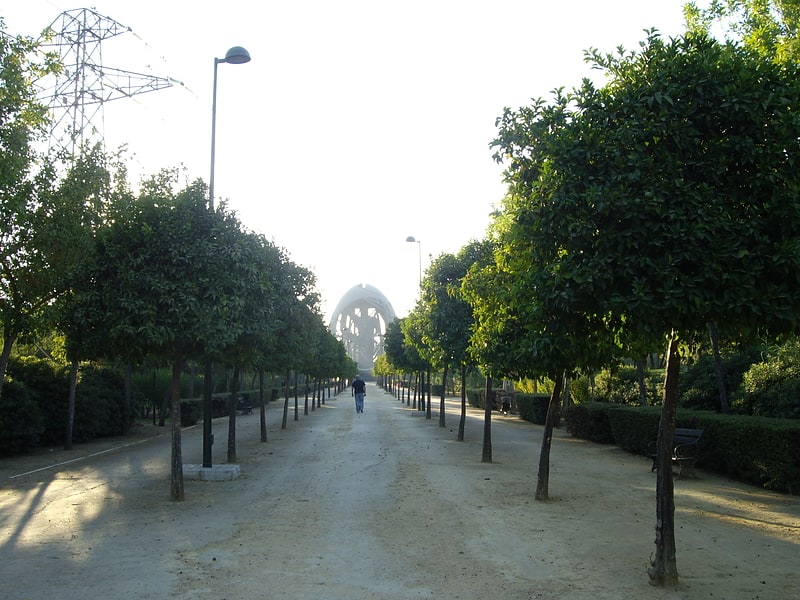
Birth of a New Man, popularly known as el huevo de Colón, is a monument in Seville, Spain. It is a work by Zurab Tsereteli, consisting of a colossal statue representing Christopher Columbus partially enfolded by an egg-like shell.
It was a gift from the city of Moscow to Seville on the occasion of the 500th anniversary of the arrival of Columbus in the Caribbean in 1492. The reported height of the sculptural work ranges from 42 to 45 metres (138 to 148 ft), while the individual figure is 32 metres (105 ft) high, thus ranking as the largest statue in Spain, ahead of the Cristo del Otero.
Located at the Park of San Jerónimo, it was inaugurated by Elena de Borbón and Jaime de Marichalar in 1995.[21]
Alamillo Park
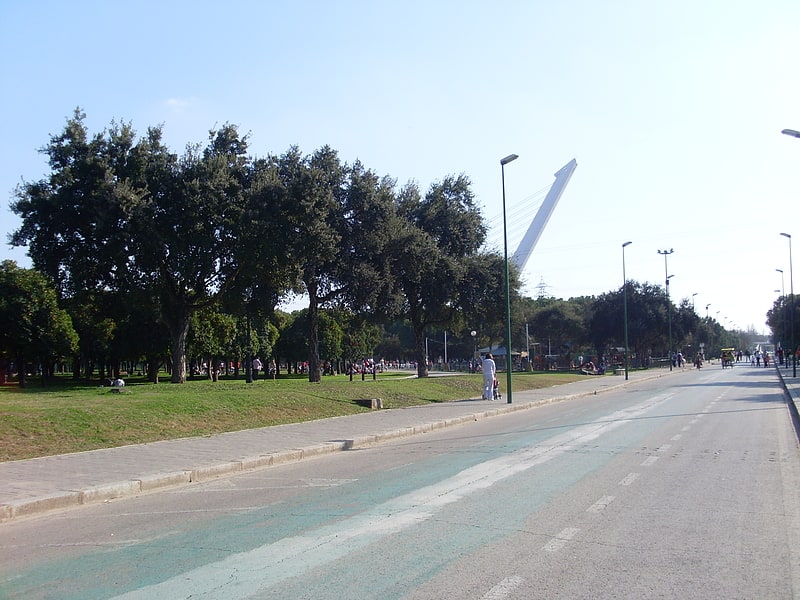
Also known as: Parque del Alamillo
Park in Spain. Alamillo Park is a metropolitan park located between the town of Santiponce and Seville, Spain. The park is scheduled to begin an expansion that will make it one of Spain's largest urban parks, reaching 120 hectares in the summer of 2013.[22]
Address: Parque del Alamillo, 41970 Sevilla (Triana)
Estadio Benito Villamarín
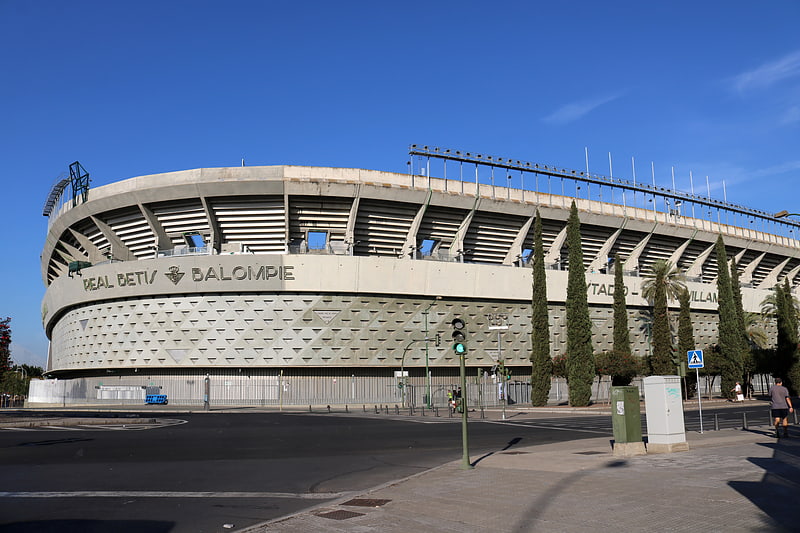
Stadium in Seville, Spain. Estadio Benito Villamarín is a stadium in Seville, Spain, and the home of Real Betis since its completion in 1929. It has a capacity of 60,720.[23]
Address: Avenida de Heliopolis, s/n, 41012 Seville (Palmera - Bellavista)
Puente del Centenario
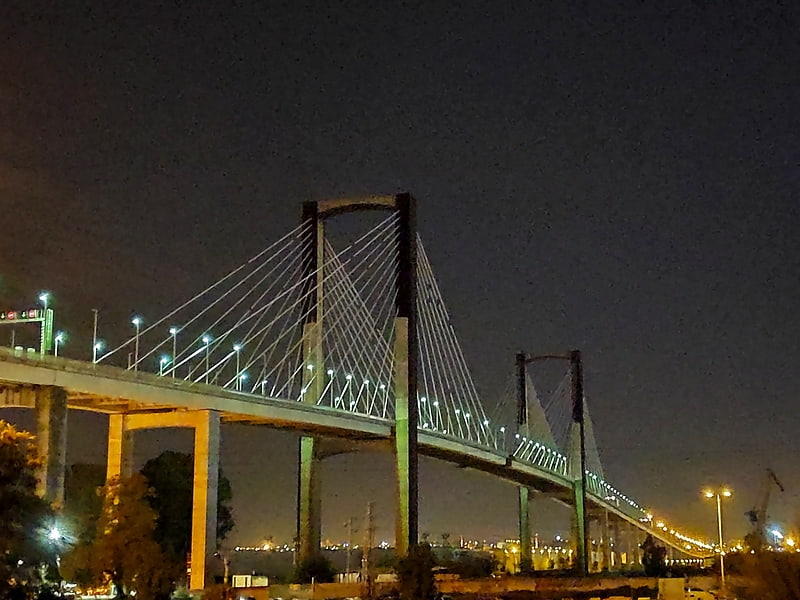
Bridge. The Centenario Bridge is a cable-stayed bridge in Seville, Spain. It crosses over the left branch of Guadalquivir.[24]
Palacio de las Dueñas

Historical landmark in Seville, Spain. Palacio de las Dueñas is a palace in Seville, Spain, currently belonging to the House of Alba. It was built in the late 15th century in the Renaissance style with Gothic and Moorish influences. The palace is one of the major historic homes in the city of great architectural and artistic heritage. The poet Antonio Machado was born here, as were Carlos Falcó, Marqués de Griñón and Marqués de Castelmoncayo. On October 5, 2011 Cayetana Fitz-James Stuart, 18th Duchess of Alba married here. It became a national monument, now a "Bien de Interés Cultural", on June 3, 1931.
The promoter of his opening to the tourist visits (2016) is the current Duke of Alba, D. Carlos Fitz-James Stuart and Martinez de Irujo. Today is one of the most visited monuments in Seville.[25]
Address: Calle Duenas 5, 41003 Seville (Casco Antiguo)
Plaza de España
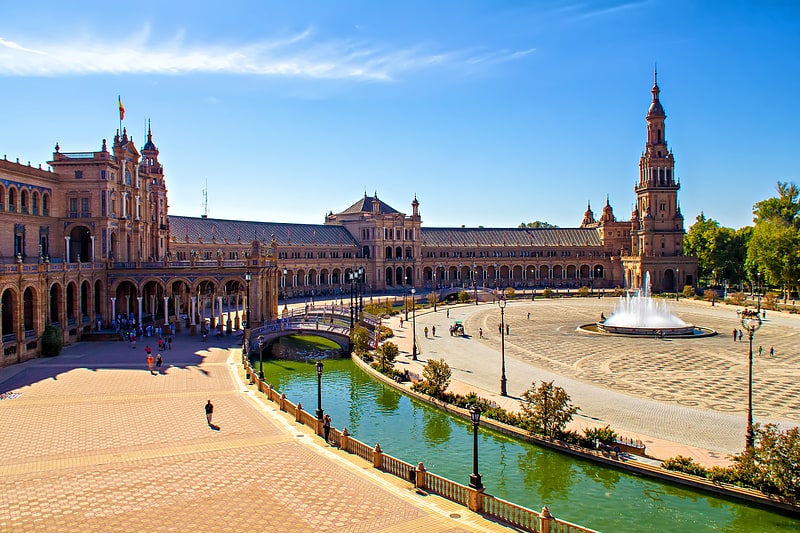
Landmark square lined with ceramic tiles. The Plaza de España is a plaza in the Parque de María Luisa, in Seville, Spain. It was built in 1928 for the Ibero-American Exposition of 1929. It is a landmark example of Regionalism Architecture, mixing elements of the Baroque Revival, Renaissance Revival and Moorish Revival styles of Spanish architecture.[26]
Address: Avenida de Isabel la Catolica, 41004 Seville (Sur)
Royal Tobacco Factory

Also known as: Real Fábrica de Tabacos de Sevilla
Historic factory, now university offices. The Royal Tobacco Factory is an 18th-century stone building in Seville, southern Spain. Since the 1950s it has been the seat of the rectorate of the University of Seville. Prior to that, it was, as its name indicates, a tobacco factory: the most prominent such institution in Europe, and a lineal descendant of Europe's first tobacco factory, which was located nearby. It is one of the most notable and splendid examples of industrial architecture from the era of Spain's Antiguo Régimen.[27]
Address: Calle San Fernando 4, 41004 Seville (Casco Antiguo)
Plaza de América
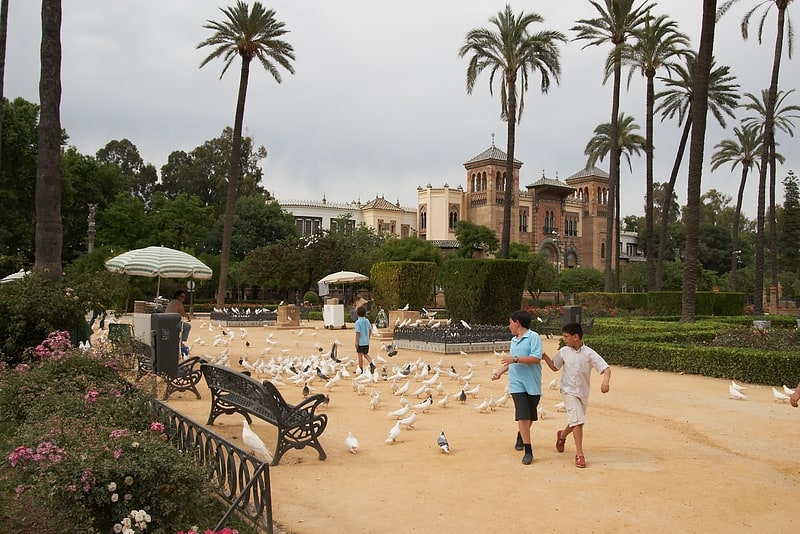
Park in Seville, Spain. The Plaza de America, located in the Parque de María Luisa, is flanked by the Museum of Popular Arts to the north, the Archaeological Museum to the south, and the Royal Pavilion to the east. These three buildings were built by the architect Aníbal González between 1913 and 1916 for the future Ibero-American exhibition in 1929, each with a different architectural style. Also form Part of the roundabout of Miguel de Cervantes, adorned with the works Ceramics Recalling Most Famous, as Rodriguez Marin.[28]
Teatro Lope de Vega
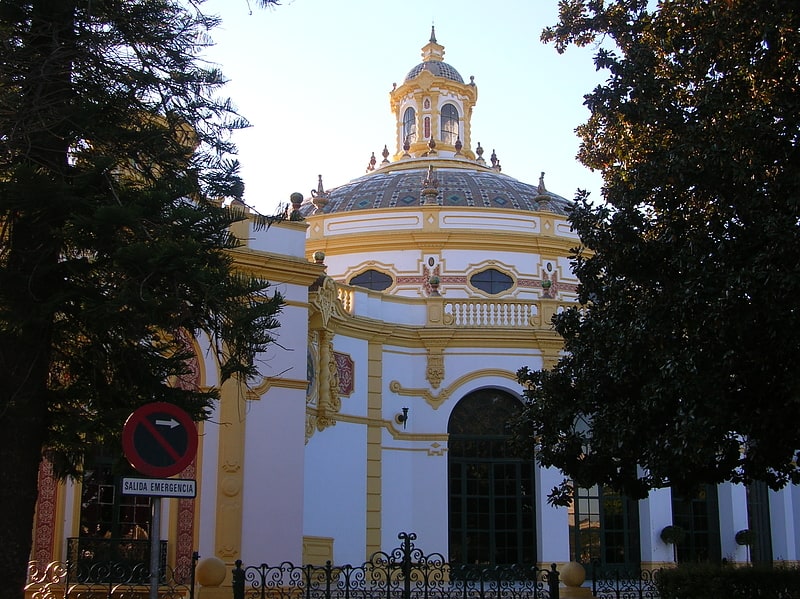
Theatre in Seville, Spain. The Lope de Vega Theatre is a small Baroque Revival theatre that was built for the Ibero-American Exposition of 1929 in Seville, Spain, in the same building as the Exhibition Casino. It stands in the Maria Luisa Park just north of the Pavilion of Peru. The theater is named after the famous 16th-century Spanish playwright Lope de Vega. After the exposition the theatre had a mixed history. It suffered damage from fire and flood. At times it was closed and at times was partially restored and reopened. The building has been used as a hospital and as a trade show venue. Following its most recent renovation the theatre has become one of Seville's most important centres for cultural events.[29]
Address: Avenida Maria Luisa s/n, 41013 Seville (Casco Antiguo)
Avenida de la Constitución
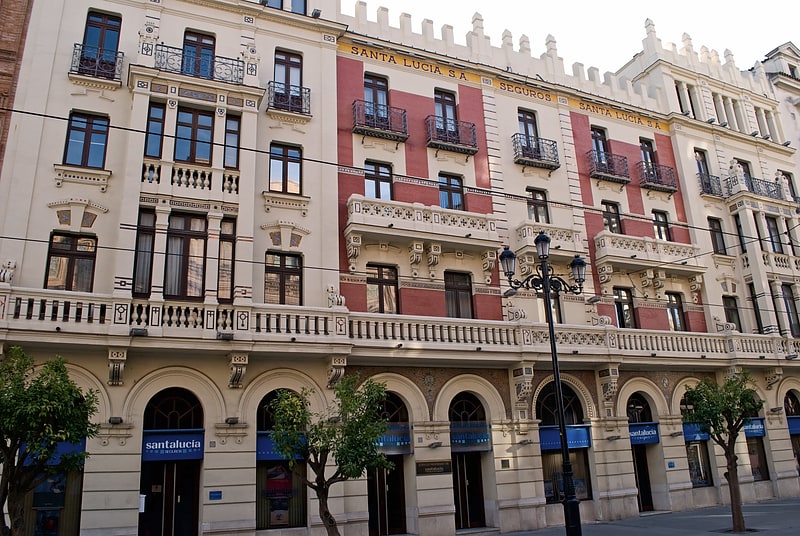
Avenida de la Constitución is an important avenue in the Casco Antiguo district of Seville, Andalusia, Spain. It starts from the square known as Puerta de Jerez and reaches the Plaza Nueva, considered the center of the city and where the historic building of the Seville City Council is located. It has a length of 600 m.[30]
Address: Avenida de la Constitución, Seville (Casco Antiguo)
Hospital de la Caridad
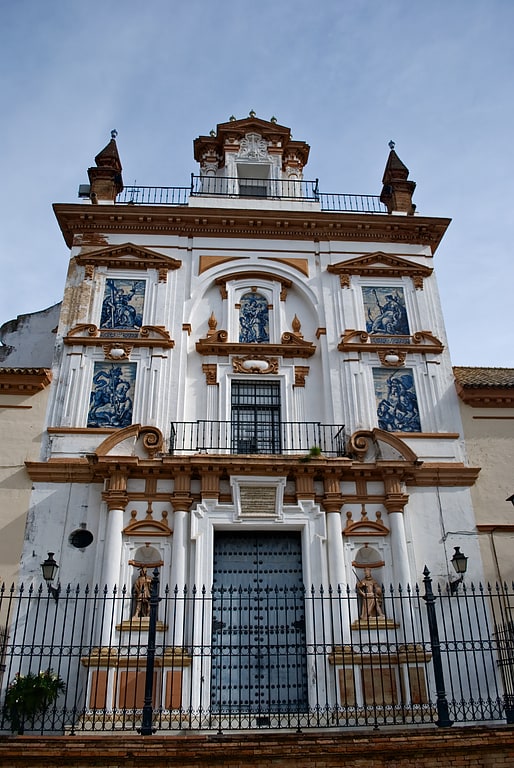
Also known as: Iglesia y hospital de la Caridad
Building in Seville, Spain. The Hospital de la Caridad in Seville, Spain is a baroque charity hospital building near Plaza de toros de la Real Maestranza de Caballería de Sevilla. The charity hospital was founded in 1674, and still cares for the aged and infirm. The hospital's chapel is open to the public and "contains some of Seville's most sumptuous baroque sculpture."[31]
Address: Calle Temprado 3, 41001 Seville (Casco Antiguo)
Metropol Parasol
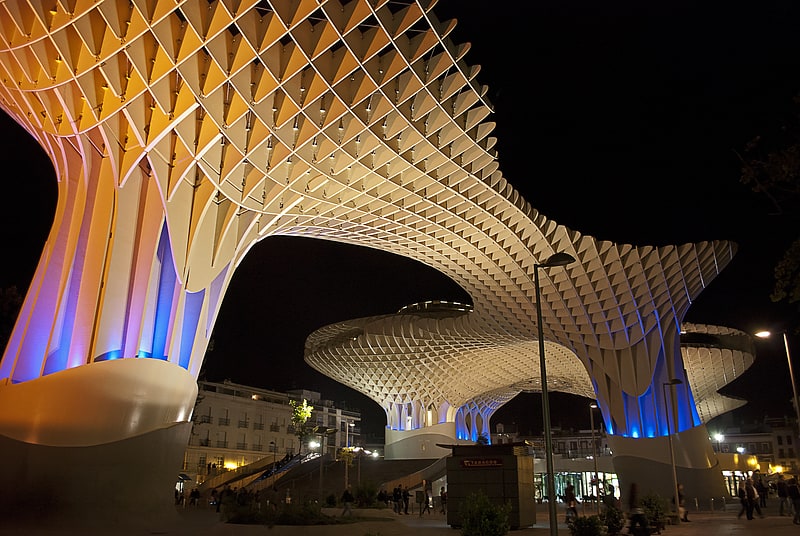
Also known as: Setas de Sevilla
Iconic wooden sculpture with viewpoint. Setas de Sevilla or Las Setas, initially titled Metropol Parasol, is a wooden structure located at La Encarnación square in the old quarter of Seville, Spain. It was designed by the German architect Jürgen Mayer and completed in April 2011. It has dimensions of 150 by 70 metres and an approximate height of 26 metres and claims to be the largest wooden structure in the world. Its appearance, location, delays and cost overruns in construction resulted in much public controversy.[32]
Address: Plaza de la Encarnacion, 41003 Seville (Casco Antiguo)
Teatro de la Maestranza

Theatre in Seville, Spain. The Teatro de la Maestranza is an opera house located in Seville, Spain.
The theatre was conceived to be one of the main cultural venues of the Seville Expo '92, and the first performance took place in 1991, shortly before the inauguration of the Universal Exposition. The theatre was refurbished in 2005.
Although the Teatro de la Maestranza is mainly devoted to opera, there are also performances of Zarzuela (Spanish operetta) and other musical performances.
The resident orchestra is the Royal Seville Symphony Orchestra (ROSS), and the artistic director is Pedro Halffter. The theatre is the ROSS' main concert venue and the home of the Choir of the Friends' Society of the Maestranza Theatre.
On 16 July 1992, during a rehearsal at the Teatro de la Maestranza for a performance by the Opéra national de Paris of Verdi's Otello, a suspended platform which formed part of the scenery collapsed onto the stage, killing a female member of the chorus and injuring a further 41 people, several of them seriously.[33]
Address: Seville, Paseo de Colón 22
Puente de la Barqueta
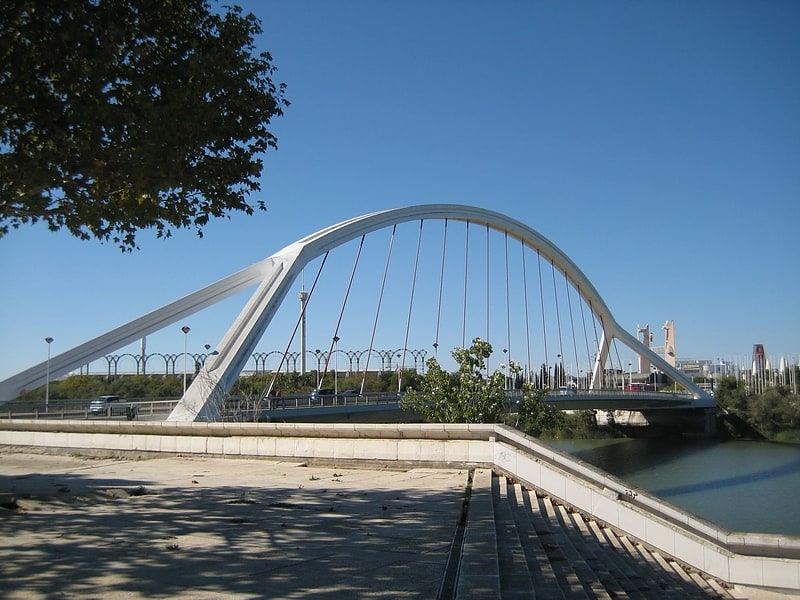
Modern landmark spanning a river. The Puente de la Barqueta, officially named Puente Mapfre, is a bridge in the city of Seville, which spans the Alfonso XII channel of the Guadalquivir river. It constituted one of the main means of access to the Isla de la Cartuja.
It was built between 1989 and 1992, on the occasion of the Universal Exposition Expo'92, and conceived as the main gate for this.[34]
Address: Puente de la Barqueta, 41092 Sevilla (Triana)
La Casa de la Ciencia
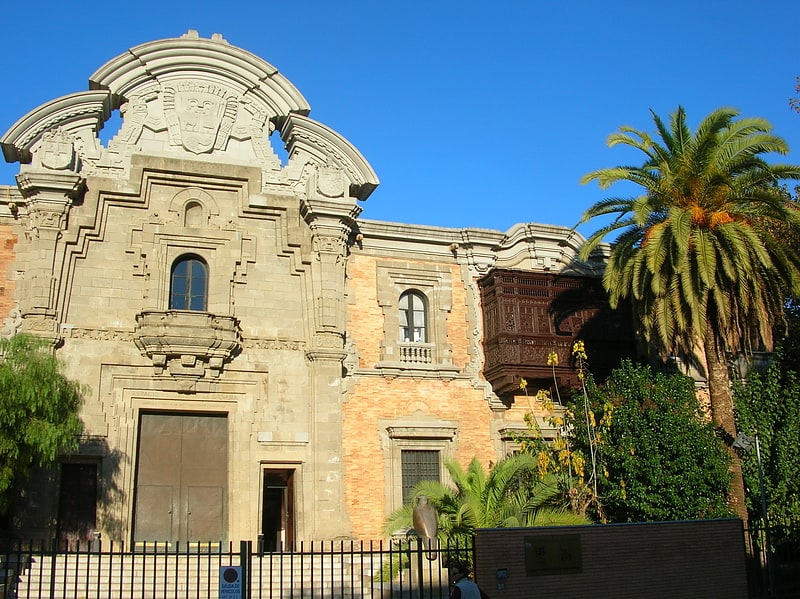
Also known as: Museo Casa de la Ciencia de Sevilla
Museum in Seville, Spain. La Casa de la Ciencia in the city of Seville, Spain is a centre for popularizing science.
Along with a museum, the building houses the Andalusian headquarters of the Spanish National Research Council (CSIC). CSIC is the largest public institution devoted to research in Spain, and the third largest in Europe. The building was opened to the public in 2008, with the goal of sharing knowledge acquired through scientific research. La Casa de la Ciencia aims to be a bridge between the scientific research community and the public, sharing contemporary scientific research and information on environmental issues. The museum achieves these goals by putting on various types of events, including exhibitions, conferences, seminars and workshops. The museum contains three permanent exhibits, one temporary exhibit and a planetarium.[35]
Address: Pab de Peru Avenida Maria Luisa S/N, 41013 Seville (Casco Antiguo)